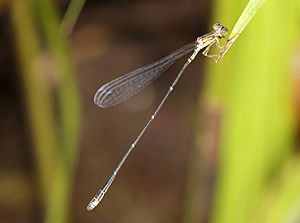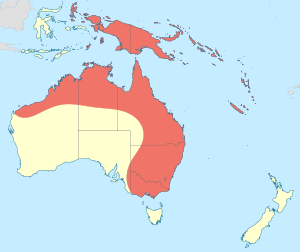Isostictidae facts for kids
Quick facts for kids Isostictidae |
|
|---|---|
 |
|
| A Slender Wiretail damselfly (Oristicta filicicola) | |
| Scientific classification |
|
| Kingdom: | Animalia |
| Phylum: | Arthropoda |
| Class: | Insecta |
| Order: | Odonata |
| Suborder: | Zygoptera |
| Family: | Isostictidae Fraser, 1955 |
| Genera | |
|
Austrosticta |
|
 |
|
Isostictidae is a small group of medium-sized to large damselflies. These insects are only found in Australia, New Caledonia, and New Guinea. There are 12 different types (genera) and over 40 known species in this family. Damselflies in the Isostictidae family look a lot like those in the threadtail family, called Protoneuridae.
Contents
What They Look Like
Isostictidae damselflies have some special features that help scientists identify them.
Adult Damselflies
Adults are usually small to medium in size. They can be anywhere from about 15 to 40 millimeters long. That's about the length of your thumb to a little longer than your index finger. Their antennae, which are like feelers, have seven parts.
Damselfly Nymphs
The young damselflies, called nymphs, live in water. They have special gills at the end of their bodies that help them breathe underwater. These gills can look like small sacs or triangles.
Where They Live and What They Do
Isostictidae damselflies are also known by many common names. People sometimes call them narrow-wings, pinflies, pins, pondsitters, or wiretails.
Their Home (Habitat)
- Water Homes: Young damselfly nymphs live in streams, rivers, and even calm river pools.
- Adult Hangouts: Adult damselflies are usually found flying around or resting near these same watery places.
- Hiding Spots: Nymphs like to hide among plants that are underwater. They also cling to tree roots, piles of leaves, and other bits of natural material in the water.
What They Eat
Both the young nymphs and the adult damselflies are predators. This means they hunt and eat other smaller creatures.
Their Habits
- Nymphs: The nymphs are "clingers." They hold tightly to things in the water so they don't get washed away.
- Adults: Adult damselflies often rest on different kinds of plants near the water.
Life Cycle
Female damselflies lay their eggs in interesting places.
- Some females lay their eggs in dry twigs that hang over calm freshwater.
- Other females might choose to lay their eggs on the bare rocks of waterfalls.

